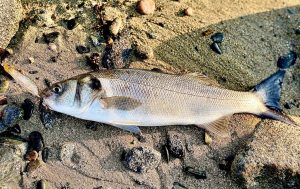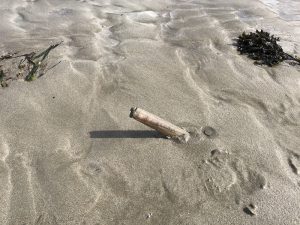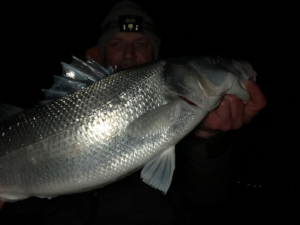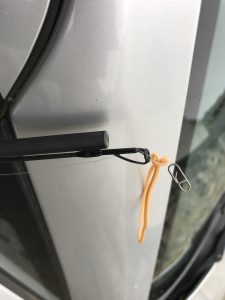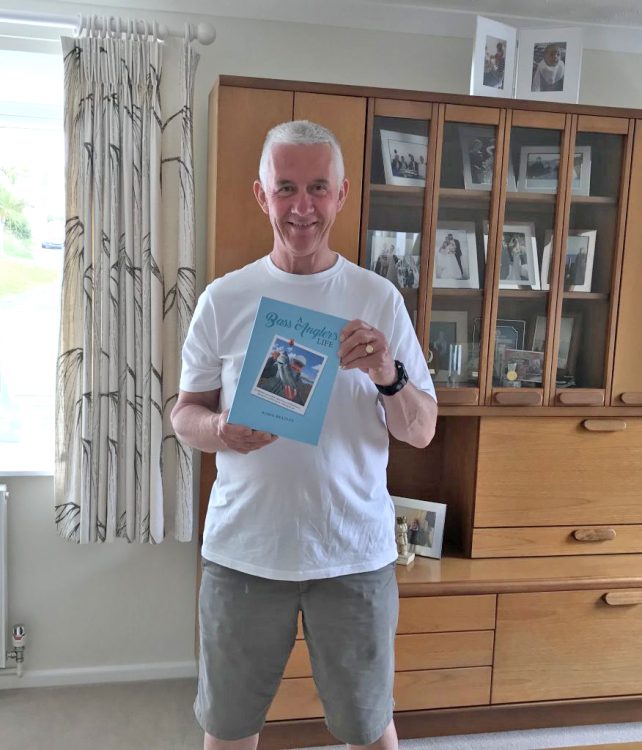Summer’s here (meteorologically speaking), following the sunniest Spring on record, which has given us a little light in these dark Corona days. This time of year always evokes strong memories for me. Not just of bass fishing in the summertime, but of family days on the beach, and trips to local events and attractions. Notable among these is the Royal Cornwall Show, the county’s biggest annual event, and very much a Cornish tradition.
Memories of the show are in turn inextricably linked with my bass fishing. Driving past the showground at Wadebridge, as the time approaches for the show and all the marquees and display rings in evidence, always makes me think of warm summer evenings spent bass fishing in some remote cove with friends. But this year is different, the normal hive of activity giving way to an empty quietness in the wake of Covid-19.

Natural bounty
Summer also brings with it a natural bounty of flora and fauna – some welcome, others not. Take ‘mayweed’ or ‘mayrot’ for example. This clingy brown stuff, which sticks to your leader knot, and ruins the action of your lure when bass fishing, has been much in evidence this year in some areas; presumably the sunny weather encouraging the growth of the algae blooms which cause it. Let’s hope the recent unsettled weather disperses it soon.
And can there be any more beautiful sight in summer than dolphins? Like many people, I’ve always had a soft spot for them. Perhaps watching ‘Flipper’ on TV in the sixties is responsible, or my life-long love of all things marine. Whatever the roots of this passion for these cuddly cetaceans, I am always stopped in my tracks by the sight of these creatures, especially at close quarters. Imagine my delight then, when Bryn Le Poidevin sent me this stunning still photo he took from a video of dolphins he shot from his boat on Guernsey.

BASS Photography Competition
Now that we all have phone cameras in our pockets most of the time, it’s easy to capture our surroundings when we’re out and about. BASS are running a free-to-enter competition looking for the best bass fishing-related photos each month. There are some great prizes on offer, so why not have a go? You’ll find all the information you need on the BASS blog. Entries can be submitted via the BASS Facebook page or the BASS Members’ Forum.
What colour is that lure?
Ever since I did Physics at school, I’ve always had a fascination for colour, or strictly speaking, what causes things to have different colours. The old mnemonic we were taught for remembering the order of the colours of the spectrum ‘Richard Of York Gave Battle In Vain’ stays with me to this day. And the idea that what we think of as white light is really a combination of these (or black an absence of them) comes to mind whenever I see a rainbow (strangely pertinent in these Corona times). Start applying this to angling and it really gets interesting.
Most of us have our favourites when it comes to lure colours, but just how important is this in terms of catching fish? My own preferences when bass fishing are natural, or silver and black colours by day, and darker colours/black or white by night, but others find brighter colours such as chartreuse or orange work best for them.

Fish have colour vision, but the colours they actually see depends on the depth of water at which the lure is working. This excellent video explains things well.
A recent post by Peter Heatlie, concerning lure colours at night, generated an interesting discussion on Lure Anglers Online (with thanks to all those who participated). In conditions of low light, colour is lost, and lures will appear varying shades of grey instead. For example, red or blue lures look almost black in these conditions, while a dark green one also looks pretty dark. These darker shades stand out against the background monochrome grey of the water at night, as will a black lure, and conversely a white one, giving the fish a better chance of seeing it. Fish have low visual acuity, meaning it’s probably not worth obsessing about lure detail, but they have high visual sensitivity – very useful for seeing things in low light conditions.
Some anglers think that colours don’t matter at night, and that vibration is much more important because bass are using their lateral line, rather than sight, to locate prey. My own experience is that ‘noisy’ lures (like a Joined Thunderstick plug) will certainly catch bass at night (especially in rougher conditions), but so will subtler lures (like a DoLive Stick soft plastic). And although I have caught bass on many different colours at night, my gut feeling is that darker ones have an edge, and conversely that white ones seem to find the better fish.
Cornish Catch & Release
Being a Personal Member of the Cornish Federation of Sea Anglers, and liking a bit of competition in my fishing, I’m going to make a point of submitting the occasional bass under their Catch and Release arrangements (that’s if I’m lucky enough to catch a decent one!).
The procedure for bass is quite straightforward – you just need a clear photo of your fish against a tape measure showing its length (in cm), making sure the snout of fish is up against the end of the tape, and that the tape is perfectly flat wherever possible. Length is measured from the snout to the tip of the tail. Photos should be emailed to the CFSA fish recorder, Simon Toms (st0467@gmail.com), by the end of each month. The weight of the fish will be calculated from this chart Bass weight length CFSA. Bass recorded like this will count for the best bass in the County award for each year.
You will need to be a member of the CFSA to take part. Anglers from anywhere in the Country may join, either as a Personal Member, or by joining an affiliated club, but only fish caught in Cornish waters may be submitted. To join as a Personal Member, please send a cheque for £10 to CFSA Secretary Ralph Elcox at ‘Wayside’, Menagissey, Mount Hawke, Truro TR4 8DQ. Ralph is also able to help those seeking to join a CFSA affiliated club.
Catch and release science
While on the subject of catch and release, I am grateful to BASS Science Group member David Curtis for unearthing this interesting report from the Environment Agency. Although about salmon, it is highly relevant to bass fishing, indeed many of the concepts discussed will already be familiar to bass anglers.
I found the physiological aspects particularly informative. Physiological disturbance and stress in fish can result in reduced survival following release. This disturbance is greater when the ‘fight’ (retrieval) is prolonged, when bankside handing is careless, and when exposure to air is prolonged, these effects being worse when the water is warmer. It can take salmon up to 24 hours to recover to their pre-fishing physiological state.
I suspect that bass are quite a hardy fish, as suggested by studies like the Cork Harbour one, which showed that 100% of fish caught with lures, and subjected to the insertion of tags, were still alive 20 days after release. Nevertheless, we each need to make informed decisions about how we increase the chances of survival of those fish we wish/have to return. On a personal note, I only use gear that allows for a quick retrieval, only measure and photograph fish which look over 60cm, and only weigh fish which are over 70cm, doing this as quickly as possible – in practice this probably accounts for less than 10 fish a year. I don’t recall any of these fish not swimming off strongly when I returned them, but it’s impossible to know if any went on to die subsequently, or be eaten by a predator.
Bait considerations
The first bass fishing of the new ‘season’ usually coincides with the spring peel of shore crabs. I’m always keen to use this excellent bait at this time of year, but getting it can be far from straightforward.
Take my first bait collecting trip of the year for example. I could tell from the footprints in the mud, that someone had been through my traps within the last couple of days. My worst fears were realised when I looked in the bucket at the end of an hour’s backbreaking toil in the stinky mud, and saw just two small peelers and one small crispy crab. In disgust, I was about to ditch them, but then I saw an angler fishing nearby, and thought they could at least have a couple of casts with them. Apart from the wasted effort involved, and the cost of the petrol to get there, I would have no bait to go fishing with, since it was not worth taking that number home. And with everyone after bream at the moment, the demand for shop-bought crab means getting hold of these is difficult. It’s enough to make you give up bait fishing!
But crab isn’t the only bait which works early in the season. A conversation with Alan Vaughan, with further encouragement from Dave Taylor, stimulated a developing interest in using cuttle as bait. They come into shallow waters in spring, dying after they have bred, and you will often see lots of cuttle bones on beaches at this time of year. Whatever has stripped the flesh from these must have had a veritable banquet, and it’s reasonable to assume that bass will be joining in the feast. My initial efforts in this direction have not yet borne fruit, but as with all things to do with fishing, there are many factors which can influence success or failure, and persistence, perhaps with a dash of luck, should eventually be rewarded.
Another less well tried bait is spider crab. If it was easier to get hold of, I’m sure spider peelers/softies would feature in many more bass catches. They are present inshore (but out of reach of the shore gatherer on dry land) from mid-May for about 3 months, often forming large mounds, with the females on the inside, as a method of protection following peeling (moulting), when the bodies are still soft. This incredible excerpt from Blue Planet II shows spider crabs marching and congregating off the coast of Australia in order to shed their shells. Apparently they can be collected from the sides of harbour walls when they are swarming, but this is not something I have tried.
Lockdown Labrax
Although still in ‘lockdown’, we’ve been allowed to go fishing for several weeks now, but to be honest, it’s not really happening for me at the moment. OK, I have had the odd fish on small surface lures and soft plastics, but nothing of any size yet.
There were quite a few fish around at the time that the fishing restrictions were lifted, but they seem to be (un)socially distancing at the moment! I suspect this is down to the fact that the first main peel of crabs is coming to an end, and the bass are looking elsewhere for their food, until the baitfish move in. Keep at it though, as I am hearing of the odd good catch, and things are changing as I speak. Richard Brandon managed this nice one towards the end of May.

June can be a very good month, indeed it was the best one for me in 2003 – in terms of numbers. I averaged 2.5 fish per trip in June that year – all on plugs. I put this down to the number of fry around at this time, which in a good year can be considerable. Given that these can be small, it makes sense to ‘match the hatch’ and smaller 9cm plugs have produced well for me at this time.
In the reports I’ve heard, 60-65cm fish seem to be featuring quite regularly. I think these come from the same cohort of fish which were giving us quite a few 55-60cm fish last year. This is a nice size (5-6lb) of fish to catch, and let’s hope some of them survive to grow even bigger.
Capturing the mood
Fishing stirs emotions deep within us. It can be hard to put this into words, but this poem by good friend Richard Brandon captures the mood of an evening’s fishing beautifully.
Out there – a new year arrival
Beneath a stooping, crescent moon the broily waters cleeve and roll. Lines divining cross the cove, to seek the sea-tribes where they shoal.
Hoping against hope they escape where the death-nets hang and ride, undersea gibbets set to make their daily rape of every tide.
Deep midnight, and a final cast flies out a further bribe of bait, the acrid tang of wrack and kelp comes and goes as the winds abate.
Within the cadence of the waves A sudden jolt. The starscapes slide. The rod bucks and a moonlit bass marks our observance of the tide.

Tight lines and stay safe
![]()




